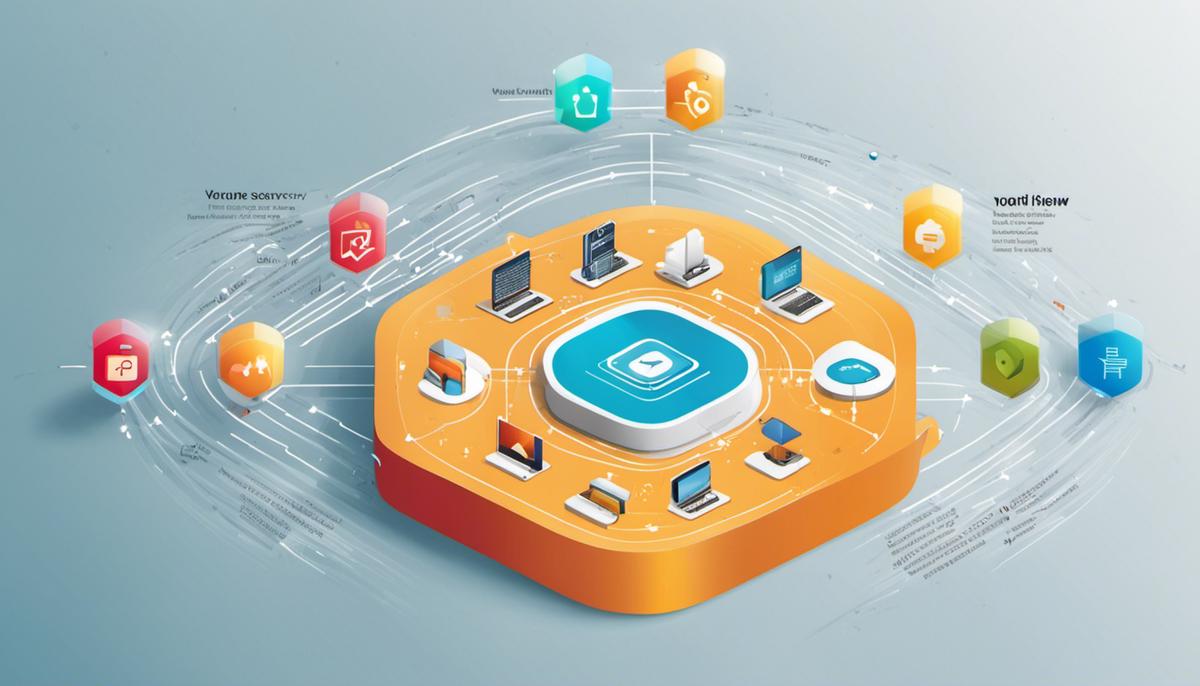A Zero Trust Security model is critical in managing cyber vulnerabilities. This model, which suggests that no user or device should be trusted by default, is fast gaining traction in the battle against cyber threats. The fundamental principles of Zero Trust challenge traditional security norms by categorically asserting that everyone and everything must be verified before being granted access. It brings a new perspective on aspects of network, data, and application security, thus warranting a thorough understanding.
The Concept of Zero Trust Security Model
The Rise of the Zero Trust Security Model: A Silicon Revolution
A radical technological upheaval is taking the world of cybersecurity by storm – The Zero Trust Security Model. A concept that sounds like an awkwardly anecdotal tech pun isn’t just lingering on the edges of corporate firewalls or glimmering in the eyes of cyber enthusiasts. Instead, it’s hell-bent on rewriting the very paradigms of data security frameworks, notching up proficiency, and fortifying defenses like never before.
Born in the encrypted hallways of Forrester Research, the Zero Trust Security Model is predicated on a simple principle – Trust Nothing, Verify Everything. A motto designed to streamline and strengthen cyber defenses in the face of escalating threats. As the digital landscape grows exponentially, the avenues for data breaches expand equivalently, posing an arduous challenge for traditional security protocols. The Zero Trust Model tackles this problem head-on by questioning and authenticating every request – even that from trusted sources.
Characterized by meticulous access controls and vigorous identity verification, the Zero Trust approach evaluates every action within the network silos. It operates with the baseline belief that breaches are not only possible but inevitable. Hence, it reinforces a least-privilege strategy – granting just enough access to get the job done and nothing more. Verification isn’t a one-time badge of trust but a constant practice deployed at every gateway.
The in-built skepticism of the Zero Trust Security Model endorses the fact that potential threats can come from both external (hackers) and internal (employees) sources. In a stark departure from conventional security models, the Zero Trust Model doesn’t assume the safety of anyone or anything. Just as we wouldn’t lend our bank details to a stranger without thorough scrutiny, Zero Trust assumes every data request as a potential threat and verifies it before granting privileges.
The astonishing rise in global cybersecurity breaches, coupled with the growing complexities of hybrid work ecosystems, has led to the meteoric popularity of Zero Trust Security. Microsoft’s report illustrates a startling 300% increase in cyber threats in 2020 alone, prompting organizations to rush toward more comprehensive security solutions like Zero Trust.
Studies also reveal that embracing the Zero Trust model correlates with greater business confidence—68.6% of organizations report improved cyber-threat detection rates, and 55.1% confirm enhanced business agility. It creates a strong foundation with its multilayered approach, instilling hope among CISOs that they might finally catch up to the speeds of digital adversaries.
In this digital age, companies handle massive volumes of sensitive data—placing an increasing premium on security measures. The Zero Trust Security Model, with its stern principles and innovative approach, is becoming the go-to solution for modern organizations. A testimony to the celebrated adage in cybersecurity – “It’s not about ‘if’ a breach will occur; it is all about ‘when’.” Enter the Zero Trust Security Model — where skepticism is a virtue.

Implementing Zero Trust Security
Shifting gears to the implementation phase, adopting a Zero Trust Security Model is not a task that can be accomplished overnight. It requires a strategic approach, an understanding of the ecosystem it’s being integrated with, constant monitoring, and a touch of flexibility to perform necessary changes.
Start with gaining an organizational consensus on the shift towards Zero Trust. It is integral to ensure that all stakeholders, regardless of their position in the company hierarchy, understand the rationale behind the transition. This clarity will aid in creating a comprehensive approach to security and achieving the collective goal of absolute information control.
The next important issue to address is technology inventory. Cataloging all the software, hardware, and data repositories used in the organization helps understand the scope of implementation. Ensure you don’t overlook lesser-utilized technologies such as Internet of Things (IoT) devices, which can be hotspots for security vulnerabilities.
Once you have a clear understanding of what needs protection, utilize a micro-segmentation approach. In this strategy, the broader network is dissected into smaller, isolated sections. By doing so, it delivers granular control over accessibility, reducing the chance that threats penetrate beyond one compartment should the security be breached.
Integration of robust Identity and Access Management (IAM) solutions stands as the next significant step. It helps in diligently managing and monitoring the user credentials, setting a sturdy gatekeeper to the information. Modern IAM solutions leverage Artificial Intelligence (AI) to anticipate possible breaches based on behavioral patterns, thus fortifying the security structure.
Another vital infusion that enhances the Zero Trust Security framework is strong security tools like multi-factor authentication and end-to-end encryption. These layers of security ensure that even if one defense layer is penetrated, the subsequent layers are still intact, protecting valuable data.
Maintain a proactive rather than a reactive stance. Continual threat-hunting activities should be built into the system to detect threats sooner rather than later. Emerging technologies like AI and Machine Learning (ML) can be employed here to predict potential threats based on user behaviors and past incidents.
Remember, however, that technology isn’t the silver bullet solution here. It’s the coexistence of brilliant minds and innovative technology that engraves a solid security footprint. Regular training of personnel is essential to ensure they respond correctly and proactively to possible threats.
Lastly, keep the implementation process iterative. Continually review and update the strategy as risks continue to evolve. Always be aware of the latest technology trends and incorporate them if they can further reinforce the security posture.
Making the shift to a Zero Trust Security Model is indeed a complex process, but the payback in the form of secure and controlled access to information is well worth the effort. Embrace this model and gear up to tackle the tech-led future, which is inundated with both opportunities and threats in equal measure.

The Challenges and Solutions in Zero Trust Security
Now that we’ve delved deep into the nitty-gritty of the Zero Trust security model let’s scrutinize the potentially arduous journey of employing it. Even the most advanced tech terms meet a certain degree of resistance in the world of implementation, and the Zero Trust security model is no exception.
Organizational inertia is one of the biggest roadblocks in the quest for Zero Trust security, possibly owing to its deviation from the traditional perimeter-based security model. This sensitivity toward change can be tackled through detailed risk assessment reports exploding the myth that internal network requests are largely safe. Fact-backing evidence on how this model can toil on infallible data-protection policies can make the transition more palpable.
Once you clear this mental obstacle, you’ll encounter the behemoth task of identifying every single asset in your tech ecosystem. Cataloging every device, application, and user is critical to define stringent access policies. Overcome this commercial Everest with robust asset management tools that harvest data continuously.
After identifying, cataloging, and creating access policies, advancing to a micro-segmentation approach could become a puzzler for many. The solution lies in layering network segments and controls, rendering it impossible for threats to propagate through the network.
Next in line is harmonizing your Zero Trust model with existing Identity and Access Management (IAM) solutions. Disparities between your IAM and Zero Trust paradigms can be ironed out by utilizing Privileged Access Management. These solutions ensure stringent controls of user access, aptly aligning with Zero Trust principles.
There’s no evading multi-factor authentication and end-to-end encryption when talking Zero Trust. To achieve this, it’s imperative to deploy advanced security solutions like biometrics, cryptographic keys, or even hardware-based authentication technologies.
Zero Trust is not just about restricting access; proactive threat hunting is its backbone. With AI and ML technologies, anomalous activities can be spotted and remedied quicker than ever.
Another overlooked challenge is training personnel to respond aptly to threats. A systematic orientation program backed by regular drills can equip your team with the expertise to manage unexpected cyber threats.
Finally, your Zero Trust model needs periodic revisions to ensure it evolves with changing threat landscapes. Ongoing audits backed by powerful analytics can help fine-tune your policies while reinforcing your security apparatus.
Now, attempts to switch to Zero Trust Security Model might seem like a battle royale, and in many ways, it is. But it’s the battle that brings forth the promise of an almost impenetrable fortress of data. Therefore, rolling up your sleeves to tackle these barriers head-on is not just rewarding but a necessity in the tech-loaded world today. There is no point in being aware of the benefits that the Zero Trust model offers if you’re not going to traverse the path leading to it, right?

Examples of Successful Zero Trust Implementation
Adopting an entirely new security model is an extensive endeavor that requires time, resources, and a shift in organizational culture. Several forward-thinking companies have taken the plunge and reaped the rewards of a Zero Trust Security model.
Google is a prime example of a successful transition to a Zero Trust security model. Their initiative, named “BeyondCorp,” treats all network traffic, internal or external, as equally untrustworthy. This approach allowed them to dismantle their traditional network perimeter and replace it with granular, user-focused access controls. Google’s case especially highlights the importance of a thoroughly cataloged technology inventory in implementing the Zero Trust model.
Other companies like Illumio and Akamai Technologies have also inaugurated Zero Trust models. Illumio’s ‘Adaptive Security Platform‘ employs micro-segmentation to simplify and streamline the implementation of Zero Trust security, while Akamai’s ‘Enterprise Application Access‘ service simplifies the Zero Trust model by avoiding VPNs and only using its globally distributed architecture.
However, it’s vital to note that these companies didn’t turn on a dime. Their transition was gradual, worked through iteratively, and involved employee training. This is reminiscent of the integration of Identity and Access Management solutions, which requires a company-wide acceptance and understanding of their necessity. Furthermore, these companies capitalized on emerging technology like AI and ML to automate processes and identify patterns indicative of cyber threats.
Financial services firm Morgan Stanley provides a different perspective, focusing on the concept of “Zero Trust Data” – the idea that security policies should assume data is always at risk. This approach allows them to automatically identify, classify, and secure data wherever it is stored or travels. This top-notch approach to data protection is another reminder of the importance of thorough implementation of encryption in the Zero Trust model.
These examples underline the importance of a tailored approach to Zero Trust Security. Each company will have unique threat vectors, requiring a customized combination of tactics within the Zero Trust framework. It’s not a one-size-fits-all solution.
Ultimately, companies like Google, Illumio, Akamai, and Morgan Stanley prove that Zero Trust is not only feasible but can lead to better overall cyber resilience. By challenging traditional security presumptions and embracing Zero Trust, they’ve positioned themselves at the forefront of a technological evolution aimed at combatting a new era of cyber threats.

It’s easier to appreciate the value of the Zero Trust Security model when looking at the experiences of the real-world organizations that have implemented it. These tangible examples shine a light on the strategies that worked, the challenges faced, and the innovative solutions that paved the way for successful Zero Trust journeys. Through such stories, the abstract concepts surrounding this comprehensive security approach become tangible and relatable. Bringing all the insights together, it’s undeniable that the Zero Trust Security model, though not without its own set of hurdles, provides a promising approach to bolstering cybersecurity in today’s increasingly vulnerable digital landscape.

